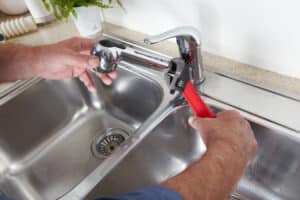 Faucets are the unsung heroes of our kitchens, facilitating countless daily tasks from dish washing to hand cleaning. However, like any well-used appliance, faucets are susceptible to wear and tear over time. Recognizing the signs that your kitchen faucet needs attention, whether it’s a simple repair or a full replacement, is crucial to maintaining the efficiency and functionality of your plumbing system. In this comprehensive guide, we’ll explore the key indicators that signal it’s time to address your faucet issues, empowering you to take proactive steps and avoid costly water damage or disruptions to your daily routine.
Faucets are the unsung heroes of our kitchens, facilitating countless daily tasks from dish washing to hand cleaning. However, like any well-used appliance, faucets are susceptible to wear and tear over time. Recognizing the signs that your kitchen faucet needs attention, whether it’s a simple repair or a full replacement, is crucial to maintaining the efficiency and functionality of your plumbing system. In this comprehensive guide, we’ll explore the key indicators that signal it’s time to address your faucet issues, empowering you to take proactive steps and avoid costly water damage or disruptions to your daily routine.
Dripping Faucets: The Telltale Sign of Trouble
One of the most obvious and common signs that your kitchen faucet requires attention is the dreaded drip, drip, drip. A constantly dripping faucet is more than just an annoying nuisance; it’s a clear indication that something is amiss with the internal components. While many dripping faucets can be remedied through simple adjustments, if the issue persists even after multiple attempts, it’s a strong signal that the entire faucet unit needs to be replaced. Ignoring a dripping faucet can lead to a significant increase in your water bills and potentially cause water damage to the surrounding areas, making prompt action a necessity.
Identifying the Culprit: Common Causes of Faucet Drips
-
- Worn-out washers or O-rings: These essential sealing components can deteriorate over time, allowing water to seep through.
- Damaged faucet stems: The internal stem that controls the water flow can become worn, leading to leaks.
- Mineral buildup: Hard water can cause mineral deposits to accumulate, obstructing the proper functioning of the faucet.
- High water pressure: Excessive water pressure can put strain on the faucet’s components, leading to leaks.
Addressing the Drip: Repair or Replace?
If a dripping faucet is the only issue you’re experiencing, a repair may be the most cost-effective solution. Replacing worn-out washers or O-rings, or even the entire faucet cartridge, can often resolve the problem. However, if the dripping persists despite these efforts, or if the faucet is showing signs of more extensive wear and tear, a full replacement may be the better long-term choice.
Leaking Faucets: A Recipe for Water Damage
Faucet leaks can manifest in various ways, from small pools of water around the base to water seeping from the handles themselves. These leaks, whether large or small, should not be ignored as they can lead to significant water damage and even the growth of mold and mildew. Leaky faucets can cause water to accumulate in cabinets, under sinks, and even on surrounding floors, leading to costly repairs and potential health hazards.
Common Culprits of Faucet Leaks
-
- Worn-out seals and gaskets: These essential components can deteriorate over time, allowing water to escape.
- Damaged faucet cartridges or valves: Internal issues with the faucet’s mechanisms can result in leaks.
- Loose or cracked faucet handles: Damage to the handles can compromise the faucet’s ability to seal properly.
- Corrosion and mineral buildup: Rust and mineral deposits can impair the faucet’s functionality, leading to leaks.
Repairing or Replacing Leaky Faucets
In some cases, a leaky faucet can be resolved through a simple repair, such as replacing worn-out washers or tightening connections. However, if the leak persists or is accompanied by other signs of wear and tear, a full faucet replacement may be the better long-term solution. Addressing leaks promptly is crucial to prevent water damage and the potential for mold growth, which can be both costly and detrimental to your home’s health.
Mineral Deposits and Corrosion: The Enemies of Faucet Longevity
Over time, the constant exposure to water can take a toll on your kitchen faucet, leading to the accumulation of mineral deposits and the onset of corrosion. These unsightly and potentially harmful issues can not only compromise the aesthetic appeal of your faucet but also impair its overall functionality.
Recognizing the Signs of Mineral Buildup and Corrosion
-
- Visible mineral deposits or scale around the faucet’s base, spout, or aerator
- Discoloration or tarnishing of the faucet’s finish
- Difficulty in turning the faucet handles or adjusting the water flow
- Reduced water pressure or irregular water discharge
Addressing Mineral Deposits and Corrosion
While some mineral buildup and minor corrosion can be addressed through regular cleaning and maintenance, extensive damage may require a more comprehensive solution. In cases where the faucet’s internal components have been severely compromised, a full replacement may be the best course of action to restore optimal functionality and water quality.
Faucet Noises: A Sign of Underlying Issues
Unusual sounds emanating from your kitchen faucet can be a telltale sign of potential problems. From squeaking and rattling to sputtering and clanking, these noises can indicate a range of issues, from worn-out washers to damaged internal components.
Identifying the Cause of Faucet Noises
-
- Screeching or squeaking sounds: Often caused by a hardened or worn-out rubber washer that needs replacement.
- Clanking or clicking noises: Can be a sign of loose or cracked internal parts, requiring further inspection and repair.
- Sputtering or bubbling sounds: May indicate an issue with the faucet’s aerator or a problem with the water pressure.
Addressing Faucet Noises
Faucet noises should not be ignored, as they can escalate into more serious problems if left unaddressed. Depending on the nature of the sound and the underlying cause, a simple repair, such as replacing a washer, may be sufficient. However, if the noises persist or are accompanied by other signs of wear and tear, a full faucet replacement may be the best solution to restore smooth, quiet operation.
Reduced Water Pressure: A Potential Faucet Problem
Experiencing a significant drop in water pressure from your kitchen faucet can be a frustrating and concerning issue. While low water pressure is often associated with problems in the broader plumbing system, it can also be a sign of a faucet-specific problem that requires attention.
Identifying the Cause of Reduced Water Pressure
-
- Clogged or blocked aerator: Mineral deposits and debris can obstruct the faucet’s aerator, restricting water flow.
- Damaged internal components: Worn-out washers, valves, or other internal parts can impede water pressure.
- Excessive mineral buildup: Hard water can lead to the accumulation of scale and deposits within the faucet, reducing water flow.
Addressing Low Water Pressure
If the reduced water pressure is isolated to a single faucet, the issue is likely related to the faucet itself rather than the overall plumbing system. In such cases, a thorough cleaning of the aerator or the replacement of internal components may be sufficient to restore optimal water pressure. However, if the problem persists or is accompanied by other signs of faucet wear, a full replacement may be the best solution to ensure reliable and efficient water delivery.
Faucet Handles: Smooth Operation or a Sign of Trouble
The handles of your kitchen faucet play a crucial role in the overall functionality and user experience. When these handles become difficult to turn or operate, it can be a clear indication that something is amiss with the faucet’s internal mechanisms.
Identifying Faucet Handle Issues
-
- Stiff or stuck handles: Difficulty in turning the handles can be a sign of worn-out components or mineral buildup.
- Loose or wobbly handles: Loose or unstable handles can compromise the faucet’s ability to seal properly, leading to leaks.
- Broken or damaged handles: Cracked, chipped, or completely broken handles may require a full faucet replacement.
Addressing Faucet Handle Problems
In some cases, faucet handle issues can be resolved through simple repairs, such as lubricating the internal components or tightening loose connections. However, if the problem persists or is accompanied by other signs of wear, a full faucet replacement may be the best course of action to ensure smooth, reliable operation and prevent further complications.
Faucet Age and Outdated Design: Considerations for Replacement
While faucets are designed to withstand years of use, even the most well-crafted fixtures have a finite lifespan. Additionally, as design trends and technology evolve, your once-modern kitchen faucet may begin to feel outdated and out of place.
Recognizing When It’s Time to Replace an Aging Faucet
-
- Faucet age: Most kitchen faucets have an average lifespan of 15-20 years, depending on usage and maintenance.
- Frequent repairs: If you find yourself constantly repairing the same faucet, it may be more cost-effective to replace it.
- Outdated features: Older faucets may lack modern conveniences, such as water-saving technology or user-friendly designs.
- Aesthetic concerns: If your faucet’s appearance no longer aligns with your kitchen’s style, a replacement can enhance the overall visual appeal.
The Benefits of Upgrading to a New Faucet
Replacing an aging or outdated kitchen faucet can offer a range of benefits, including:
-
- Improved water efficiency and cost savings
- Enhanced functionality and user experience
- Seamless integration with your kitchen’s design
- Increased home value and appeal for potential buyers
When the time comes to replace your kitchen faucet, consider investing in a high-quality, modern fixture that not only addresses any existing issues but also elevates the overall aesthetic and functionality of your kitchen.
Mold and Mildew: A Telltale Sign of Faucet Leaks
The presence of mold or mildew around your kitchen faucet is a clear indication that a leak is occurring, even if it’s not immediately visible. These unsightly and potentially harmful growths can thrive in the damp environments created by faucet leaks, causing further damage to your cabinetry, countertops, and even the surrounding walls.
Identifying Mold and Mildew Issues
-
- Discoloration or dark spots around the faucet base or under the sink
- Musty odors emanating from the faucet or surrounding areas
- Visible mold or mildew growth on surfaces near the faucet
Addressing Mold and Mildew Caused by Faucet Leaks
Addressing mold and mildew issues requires a two-pronged approach: first, identifying and resolving the underlying faucet leak, and then properly cleaning and treating the affected areas. Failure to address the root cause of the leak can lead to the recurrence of mold and mildew, making it essential to take prompt action to restore a healthy, safe environment in your kitchen.
Water Quality Issues: A Potential Faucet Problem
In some cases, the quality of the water flowing from your kitchen faucet can be a telltale sign that the faucet itself may be the culprit. Unusual tastes, odors, or discoloration of the water can indicate issues with the faucet’s internal components or the materials used in its construction.
Recognizing Water Quality Problems
-
- Metallic or rust-like taste in the water
- Foul or unpleasant odors emanating from the faucet
- Discoloration of the water, such as a yellowish or reddish tint
Addressing Water Quality Issues
If the water quality problems are isolated to a single faucet, the issue is likely related to the faucet itself rather than the overall water supply. In such cases, a thorough cleaning or replacement of the faucet’s internal components, such as the aerator or valves, may be necessary to restore the water’s purity and taste. However, if the problem persists or is present in multiple faucets throughout the home, it may be indicative of a broader water quality issue that requires the attention of a professional plumber.
Faucet Cracks and Damage: A Clear Sign of Replacement
While faucets are designed to withstand regular use, they can still succumb to physical damage over time. Cracks, chips, or other visible signs of wear on the faucet’s exterior can compromise its structural integrity and lead to leaks, water damage, and even safety concerns.
Recognizing Faucet Damage
-
- Visible cracks or chips in the faucet’s body or handles
- Damaged or missing components, such as the aerator or spout
- Loose or unstable faucet mounting, indicating structural issues
Addressing Faucet Damage
In the case of significant physical damage to your kitchen faucet, a replacement is typically the best course of action. Attempting to repair a cracked or severely damaged faucet may provide only a temporary solution and could lead to further complications down the line. Investing in a new, high-quality faucet not only restores the functionality and safety of your plumbing system but also enhances the overall aesthetic of your kitchen.
Poor Water Flow: A Potential Faucet Problem
Experiencing a significant reduction in water flow from your kitchen faucet can be a frustrating and concerning issue. While low water pressure is often associated with problems in the broader plumbing system, it can also be a sign of a faucet-specific problem that requires attention.
Identifying the Cause of Poor Water Flow
-
- Clogged or blocked aerator: Mineral deposits and debris can obstruct the faucet’s aerator, restricting water flow.
- Damaged internal components: Worn-out washers, valves, or other internal parts can impede water pressure and flow.
- Excessive mineral buildup: Hard water can lead to the accumulation of scale and deposits within the faucet, reducing water flow.
Addressing Poor Water Flow
If the reduced water flow is isolated to a single faucet, the issue is likely related to the faucet itself rather than the overall plumbing system. In such cases, a thorough cleaning of the aerator or the replacement of internal components may be sufficient to restore optimal water flow. However, if the problem persists or is accompanied by other signs of faucet wear, a full replacement may be the best solution to ensure reliable and efficient water delivery.
Maintaining the health and longevity of your kitchen faucet is essential for ensuring the smooth operation of your plumbing system and preventing costly water damage. By staying vigilant for the telltale signs of faucet issues, such as drips, leaks, mineral buildup, and reduced water flow, you can take proactive steps to address problems before they escalate. Remember, a well-functioning faucet not only enhances the efficiency of your kitchen but also contributes to the overall aesthetic and value of your home.
—
We Provide Faucet Installation and Repair
When it comes to faucet repair and installation services, it is important to choose a reliable and experienced plumber. A well-functioning faucet is essential for any household or commercial space, as it ensures smooth water flow and prevents leaks.
> Learn More
Contact Us (859-384-3467) for a Consultation
—
 About Joe Lay & Sons Plumbing
About Joe Lay & Sons Plumbing
Serving Northern Kentucky and Greater Cincinnati Since 1970!
Joe Lay & Sons Plumbing can quickly and efficiently handle your plumbing requests with little disruption to your day-to-day! Our team of experienced and skilled plumbers can handle most residential and commercial plumbing problems. We want to reduce your stress and save you money. We keep our prices competitive, so you can use our services without breaking the bank.
> Learn More

 About Joe Lay & Sons Plumbing
About Joe Lay & Sons Plumbing